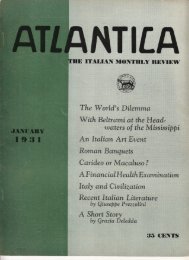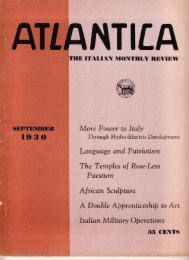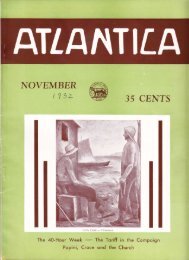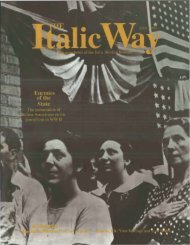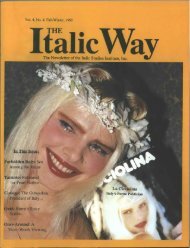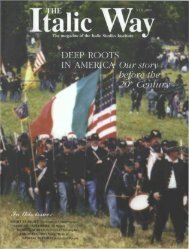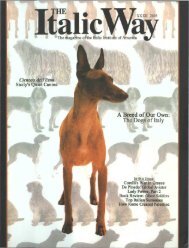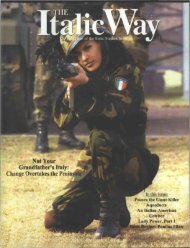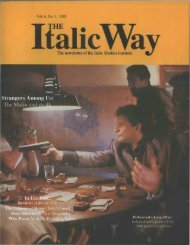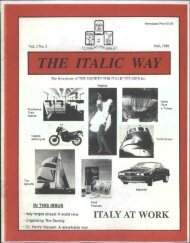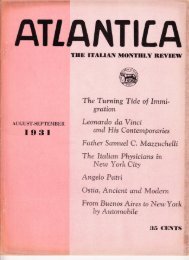L
Atlantica June 1931 - Italic Institute of America
Atlantica June 1931 - Italic Institute of America
- No tags were found...
Create successful ePaper yourself
Turn your PDF publications into a flip-book with our unique Google optimized e-Paper software.
of being a creature of theearth, that she reposes in anew sense of her reality andher individuality. And allaround \re no ionger find them1-stic golclen background buthorizontai expansion, space.The man of tire Renaissanceconquers space with his energies(the great explorations,the discoveries of new contirentsare the expression andtlie resuit of this conquest) aslie conclters time, knowleclge ofthe ages before him with lfsnind. ,tnd these material andspiritual conquests awaken andnourish in him the proudconsciousuess of his possibilities,of his personality. Perspectir.ein painting is rlothingelse but the expressionof tiris irorizontal expan-,qion, of this conquest of space,of air, of distance, of depth,of atniosphere, of ali the surroundingrrorlcl which gives anew backgrunnd, a ne\\. realit-v,a ne\v liveliness to the hurrranfigure stantling in the centerof the painting like a king inliis kingdom: the earth below,the air arourld, the skrt above.The skr'" Ihe aboue, is there,but in hannonv, in agreement,with tLe glorious immensity ofthe x-orlcl gir.en to man. Sometiures,howe\.er, a force froma b o v e suclclenh- overpo\\rersagain the man of the RenaisyIYSTICISNiAND IIIDIVIDUALISM-GIOTTO251i,r'ace the space around just aslullr- as the space abol-e.\tr/E feel the same urge iuVV painting-the same prer-ailinghorizontal sense, whichzrnnounces the Renaissance,while the medieval vertical,:ense dies away. The newis'Lu:e r,vhich arises in thepaintings of the Renaissancei-r broader and physicall,v,rtronger than the medievaligure was. We feel the realitlof the bod"v, within thegarments. we feel that theligure stands firmly on the-sround,conscious anci proudsance. Earth and space darkenagain around him, the verticalaspiring line is reestablishedand we have a sudden outburstof mysticism in tremendouscontrast with the atmosphereof the age. \\re have then, forinstance, the supreme mysticvisions of Botticelli and sometimesless profound and lastingtransformations; the ecstasyof Benvenuto Cellini in thedungeon of Castel S. Angelo.-I-HE pairrtirrg oI tlre Trecerrrto expresses tlLe transiiionfrom the ideai of the MiddleAges to the ideal of theRertaissance. It is still transcendentand m;-stic but oftenalready reveais a ne\v power'-ful sense of human realitl-.\\re perceive in it the sunset ofone ideal and the dawn of another.At times the m5.'sticIight is still vivid, intense, attimes it begins to pale in frontof the new dan'ning light.Giotto is perhaps the most representativeartist of the Trecentobecause in liis work thesetrvo extremes, the deciiningmedieval spirit ancl the g{owingRenaissance spirit, blendin a harmonv which is quite hisown ancl rvhich is just asunique as the harmony whichI)ante attained. He is stil1 thepoet wh.o designs spirits, asD'Annunzio says in a beautifulsonnet, and -vet his figures havea concrete, breatiring vitalitvn-hich is entirely new.Lookirrg at his greatestachievemerit, at the frescoes inin the chapel of the arena atPadua, \\'e have the feeling thatGiotto's art is like a propheticclream in which the art ofl{asaccio already sets forth itsfirst lines-but vaguel1., clelicatel--v,exactlr- as in a dream.The new soul is still suspcnrled,is not 1'et incarnatecl.Tl' we ('onrpare tlre I'lorerrtirreI painler n'lro opetrs tlLe artof the Trecento, Giotto, tothe tr'lorentine painter whocloses that art, Beato Angelico,we are struck b.v the profoundclifference betr,r-een thern. BeatoAngelico is the last greatrepresentative of tr'lorentinemysticism in the Quattrocento,as Gentile Da Fabriano is thelast representative of Urn-brianmysticism, and }fatteo diGiovanni l.ill be the last greatrepresentative of Sienese mysticism.Angelico gradually assimilatedsomething of thereaiistic, technical del'el opmentof (Juattrocento art, especialh'in his Roman paintings. He,rvho had &hva;'s livecl a life ofsilence and contemplation inliis F lorentine monasterv, suddenlvfound himself in the resplendentcourt of the Pope.The life and atmosphere he saware delicatell'reffecte,l in lrisfrescoes at the \ratican. \\resucldenl-v note a new liveliness,a new sense of form and mol'ement,a new instinct for theinstantaneous expressions ofiife in that great creation. Thechapel of Nicholas V approachesAngelico to the otherpainters of the Quattrocentowhro will follorv, especiaily tohis pnpil, Benozzo Gozzoli. Butbehind this superficial aclaptationto the new atmosphere,tlie spirit of Angeiicb's art remainsthe same; to the end ofhis life he remains the risionarvfriar of San Marco.fYe thlLs har.e a very fascinatingcontrast between Giotttrancl Angelico. Giotto is nafinrallvmore meclieval, moreprirnitive, in his technique.But in his spirit he is morekeenlv sensitive and open tothe clawning spirit of theRenaissance than the friar,Reato Angelico. IIe is alreat']rvaguel-r-inspirecl bv the firstbreath of that new life. InAngelico's days that breatlihad beconie a wincl-a 1'1111which onlv tonchecl hirn liglitlrin Rome; in liis Florentinenronasten' he ilicl not feel it.



